Navigating each step of your dog’s total hip replacement—from prepping for the surgery to dog hip replacement recovery—can feel overwhelming. Integrative veterinarian Dr. Julie Buzby explains the process to help you know what to expect. Learn about the pre-operative process, the total hip replacement surgery itself, and the post-operative recovery phase.
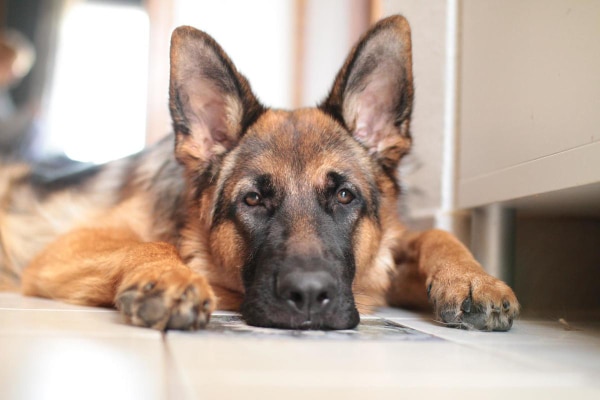
People aren’t the only ones who can have a hip replacement. Veterinary surgeons can perform total hip replacements in dogs, too!
Don’t fret; not every case of hip dysplasia in dogs, for example, requires a total hip replacement. But for severe issues, canine total hip replacement can be life-changing.
Is a total hip replacement right for your dog? Read on and speak with your veterinarian about whether total hip replacement might be what your dog needs to put the spring back in his step.
What is a total hip replacement in dogs?
As the name implies, a canine total hip replacement (THR) is a procedure that surgically removes your dog’s entire hip joint and replaces it with an artificial joint. Many orthopedic surgeons consider a THR to be the gold standard treatment for large breed dogs with significant hip disease. However, it is also an option for small breed dogs and cats, too. THR usually does a good job of providing near-normal hip function and significantly reduces pain in dogs.
Hip joint anatomy
Before we move on, let’s quickly review some basic canine hip anatomy.
The hips function as a type of joint called a “ball and socket” joint. The “ball” is the head of the femur (i.e. thigh bone). And the “socket” is the acetabulum (or cup) within the pelvic bone.
Since the hip joint is a ball and socket joint, both facets of the joint are replaced during surgery to restore and maintain normal mobility. More specifically, total hip replacement surgery replaces both the head of the femur and the acetabulum with a synthetic implant made of plastic or metal.
Why might a dog need a total hip replacement?
Although not every case of hip arthritis calls for a total hip replacement, osteoarthritis in dogs secondary to hip dysplasia is the most common reason a dog needs this surgery. In addition, trauma to the hip joint such as a fracture or dislocation, or a condition called Legg-Calves Perthes disease (i.e. avascular necrosis of the femoral head), can also lead to a damaged, painful hip joint.
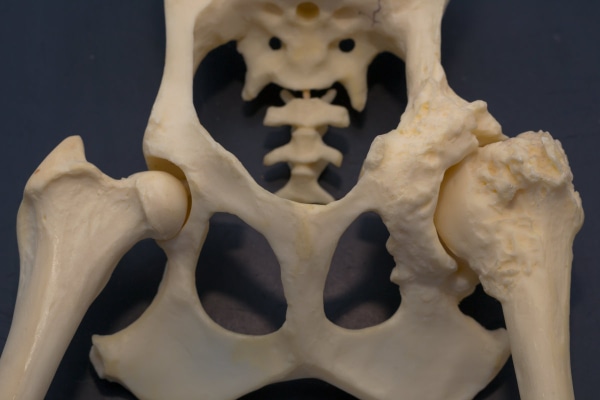
Hip dysplasia in dogs
Hip dysplasia is caused by a combination of genetic and environmental factors. Sometimes signs are apparent in young dogs, and sometimes we don’t know a dog has hip dysplasia until they are much older.
For younger dogs that are clinical for hip dysplasia, alternative surgical procedures such as a triple pelvic osteotomy (TPO) or juvenile pubis symphysiodesis (JPS) may be recommended. These procedures can prevent more severe hip problems later in life. Unfortunately, JPS must be performed by 4-5 months of age, and TPO generally by 6-12 months.
As hip dysplasia progresses, the head of the femur and the acetabulum become rough and malformed. (See photo above.) The cartilage that normally cushions and protects the joint breaks down, causing the bones to rub painfully against each other with every step.
Management options for hip pain: Medical management or surgery
Some dogs with mild symptoms can be well managed with non-surgical treatment of hip dysplasia — such as pain medication, joint supplements, rest, physical therapy, and weight management.
However, more severe or painful cases of hip dysplasia often cannot be adequately medically managed. In those instances, surgery might be indicated. There are two main surgical options to address painful hips in adult dogs:
- Femoral head ostectomy or FHO (i.e. removing the head of the femur)
- Total hip replacement
A femoral head ostectomy can be performed in dogs of any age. On the other hand, dogs generally need to have finished growing and to be skeletally mature for a total hip replacement.
How do I know if my dog needs a total hip replacement?
If your dog’s hip pain isn’t responding well to medical management, your veterinarian may refer you to a veterinary orthopedic specialist.
The orthopedic surgeon will examine your dog carefully to determine if a total hip replacement is the right choice. The surgeon will watch your dog walk and will carefully palpate and manipulate the joints.
After finding the problem areas, the orthopedic surgeon may recommend X-rays to further evaluate your dog’s bones and joints. Sometimes dogs need to be sedated or anesthetized in order to be positioned and to lie still for X-rays. In some instances, surgeons may request advanced imaging such as MRI or CT scans.
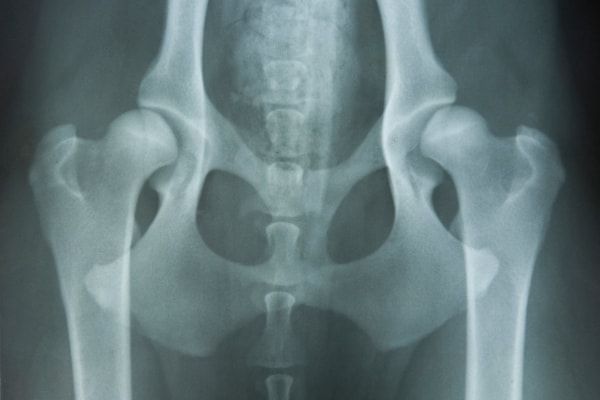
Based on the results of the examination and imaging, the orthopedic surgeon will discuss the recommended course of action for your dog. They may recommend a total hip replacement, a different surgical procedure, or modifications to the existing medical management plan.
If your orthopedic surgeon recommends a total hip replacement, numerous preparations need to be taken before the procedure.
What is the preparation like for a total hip replacement?
You, your dog, the orthopedic surgeon, and the surgical facility can work together leading up to surgery to prepare.
Patient preparation
The orthopedic surgeon may request specific testing to ensure your dog is a good candidate for total hip replacement surgery and for anesthesia. Typically, this involves:
- Bloodwork to assess organ function, red blood cell numbers, and clotting capabilities prior to anesthesia and surgery
- Urinalysis to be sure there are no problems such as a urinary tract infection in dogs
- X-rays to look for any major changes in the joint prior to surgery (if your dog doesn’t have a recent set of X-rays)
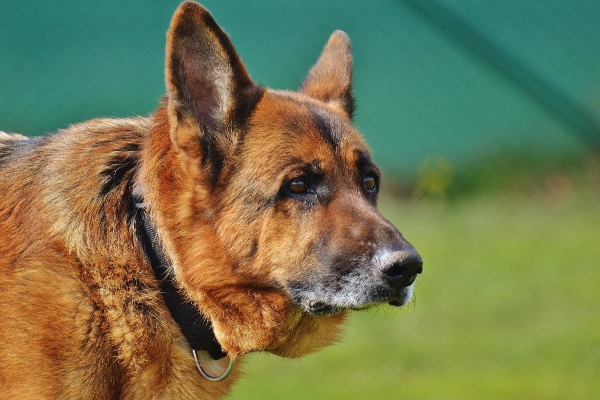
Additionally, the surgeon will advise you about any modifications to your dog’s medication and supplement plan in the days proceeding the surgery. Also, sometimes the surgeon will recommend you use a special soap on your dog’s skin prior to surgery.
Pet parent preparations
Although your dog is the patient, you can prepare for his or her THR as well. Ask the surgeon what to expect post-operatively, and what you can do once your dog comes home to keep him or her comfortable. Sometimes special equipment such as ramps, slings, or ToeGrips® dog nail grips can improve your dog’s recovery after surgery.
Be sure to follow all pre-operative instructions carefully. Make sure you know what medicine you can and cannot give your dog before surgery, how long to withhold food or water prior to the procedure, and how else you can help prepare your dog appropriately. Remember that you, your veterinarian (and veterinary surgeon), and your dog are a team!
Surgical facility preparations
Performing a specialized surgery like a total hip replacement in dogs also requires specialized equipment and staff preparation at the surgical facility. This includes:
- Training specific to the type of THR being performed
- Specialized surgical instruments
- Advanced imaging equipment
- The highest level of sterility (including specialized surgical attire for all staff involved in the procedure)
- Surgical assistant(s) and/or veterinary nurses dedicated to your dog’s specific pre-op and post-op care
Remember that, in general, canine total hip replacement surgeries are performed by board-certified veterinary surgeons. This means they not only have graduated from veterinary school, but have also completed post-grad training in internships and residencies, and have taken very difficult board examinations in order to gain these specialized skills.
How is a hip replacement surgery performed?
On the day of surgery, the surgical and anesthesia teams will examine your dog and review the surgical plan. Once your dog is put under general anesthesia, he or she is carefully monitored for the entire procedure and recovery period.
Now the surgical team can get to work. During the procedure, the orthopedic surgeon will remove the head of the femur. Then he or she will replace it with a new metal “ball.” He or she will also remove the acetabulum of the pelvis to make room for a new “socket.”
Your dog’s surgeon may use a cemented implant, a cementless implant, or a combination of both types, to replace the hip joint. As the name implies, a cemented implant uses a glue-like adhesive (i.e. bone cement) to attach the metal implant to the bone. Alternatively, a cementless implant fits tightly within the bone. It may have a sponge or honeycomb meshwork that the body “fills in” with new bone to anchor it in place.
There are pros and cons to each type of implant, but both options can be very successful. The orthopedic surgeon will choose a type of implant based on his or her training and your dog’s disease and anatomy.
As you might imagine, THR is a very involved surgery, and on average can take about two to three hours. Veterinary orthopedic surgeons are highly skilled, and will make sure everything fits together just right to give your dog the most pain-free post operative life possible.
What happens after total hip replacement surgery?
At the conclusion of the total hip replacement, the anesthesia team settles your dog into the recovery suite. They will keep a close eye on your dog to ensure he or she comes out of anesthesia as smoothly and safely as possible. Part of this includes addressing any signs your dog is in pain upon waking up.
How long will my dog stay in the veterinary hospital after surgery?
If your dog is relatively healthy, and has no pre-existing conditions, he or she may be in the hospital for just a day or two after surgery. However, some dogs need to stay in the hospital for three to four days after surgery. This time allows the veterinary team to ensure your dog is strong enough and comfortable enough to go home.
While in the hospital, your dog will have a team of people monitoring his or her recovery progress. Your dog’s veterinary team will make sure he or she is eating and that any nausea is under control. The team will also administer medications to control your dog’s pain and help him or her get outside to go potty.
Ultimately, the veterinary team wants to make sure your dog can get around ok (with some help), is eating, and has a pain level that can be managed with oral medications. Until that point, the best place for your pup to be is in the hospital.
How can you help your dog recover at home?
When your sweet pup is discharged from the hospital, you will receive post-operative care instructions and medications to give at home. Monitor the incision for signs of redness, swelling, pain, or discharge. If you notice any of these signs, it is important to notify your vet’s office right away.

Just like with other types of surgery, it is important to keep your dog from licking the incision. Otherwise, your dog could pull out the sutures/staples and cause an infection. So keep an E-collar (cone) on your dog at all times until you get the all clear from your vet.
Home modifications
Dog hip replacement recovery is quite involved. You can make your home as “recovery friendly” as possible for your dog’s return home. Consider taking the following steps:
1. Make a plan for assisting with your dog’s mobility
At first, it may be difficult for your dog to rise to a standing position or get outside to go potty. One option is to ask your dog’s care team to show you how to use a towel as a support sling.
Alternatively, you may want to purchase a special mobility harness. Two of my favorites are the GingerLead® Support and Rehabilitation Harness or the Help ‘Em Up® Mobility Harness. These products are not only more comfortable for your dog than a towel, but they are also better for your back! Especially if your dog may need longer-term support, consider investing in a mobility harness.
2. Minimize the number of stairs your dog will need to traverse
Ideally, you would minimize the number of stairs your dog must go up and down. However, that isn’t always possible. If your home has stairs, ensure they have a non-slip surface. If the stairs are not carpeted, consider applying non-slip traction stickers.
Stairs are also an area that I recommend supporting your dog with a towel or harness for the immediate post-op period. Blocking off the stairs with a baby gate or other barrier can prevent your dog from trying to traverse them before he or she is physically ready.
3. Give your dog the gift of traction
Hardwood or tile floors can be difficult for a dog to navigate safely while recovering from a total hip replacement. To help your pup out, you may wish to use carpet runners or yoga mats to make non-slip pathways throughout your home.
A wonderful alternative (or addition) to creating pathways in your home is applying Dr. Buzby’s ToeGrips® dog nail grips. These rubber rings slip onto your dog’s toenails to help him or her get traction on the floor. They go everywhere your dog goes. This means you don’t have to worry as much about what happens if your dog strays off the carpet runner pathway.
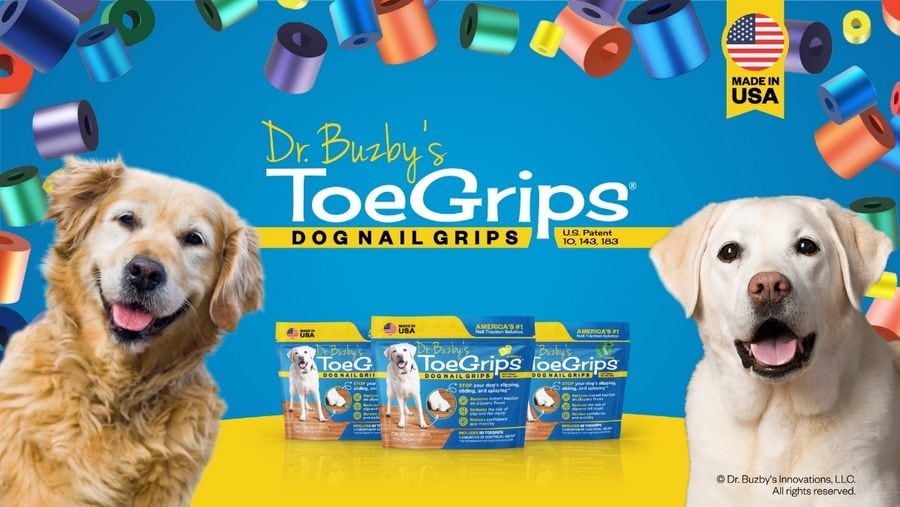
Being able to gain traction on the floors also gives your dog more confidence when moving around. Additionally, this improved grip makes it less likely your dog will fall and injure his or her healing leg.
Exercise restriction
You will also need to restrict your dog’s activity for several months after surgery. At first, the surgeon may want you to keep your dog in a confined area (like a crate). Off-leash outdoor activity is very dangerous in the immediate post-op period. Short leashed walks to go potty are ok, but we don’t want your dog to take off after a squirrel right after major orthopedic surgery.
You should also avoid letting your dog run, jump, roughhouse with other pets, do zoomies, etc. during the recovery time.
I know this isn’t easy. But it is essential to a successful outcome. Your dog’s pain may lessen to the point that he or she wants to run and play (especially if he or she was having a lot of pain before surgery). Don’t give in!
To allow full and complete healing you must keep your dog quiet and calm until your vet gives you the ‘all clear’ to begin activity again.
When your dog is allowed to return to a normal activity level, increase exertion gradually. You may have a list of exercises to do with your dog at home. Alternatively, the surgeon may recommend seeing a veterinarian who specializes in rehabilitation. Your dog may have a lot of fun with his rehab visits as he or she learns to use balance balls or exercises on an underwater treadmill for dogs.
Support your dog’s joints
I like to recommend Dr. Buzby’s Encore Mobility™ hip and joint supplement to all my patients who have joint surgery. The green lipped mussel for dogs and deer antler velvet in Encore Mobility have wonderful anti-inflammatory and healing properties. Plus, it is a great way to support your dog’s joints long term.
Be your dog’s advocate
If at any point in the recovery process, you have concerns about how your dog is doing, please don’t hesitate to reach out to the surgeon or your regular vet. You know your dog. So if something doesn’t seem right, trust your intuition.
What are the potential complications of a hip replacement?
When it comes to hip replacement complications, the good news is that serious post-op problems happen in only 5 to 10% of canine patients. The main risks include:
- Infection
- Nerve damage
- Fracture of the femur
- Loosening of the metal implant
- Hip luxation (i.e. slipping out of place)
What if my dog is limping after a hip replacement?
If your dog is limping after a total hip replacement, it is important to speak with your veterinary surgeon right away. Hopefully, it is something as simple as your dog having sore muscles from “over-doing it.” In that case, your dog may simply need stricter activity restriction and have a bit of extra pain relief for a short period of time.
However, limping after initially walking better could also be a sign of a more serious complication. It is always best to check with the surgeon.
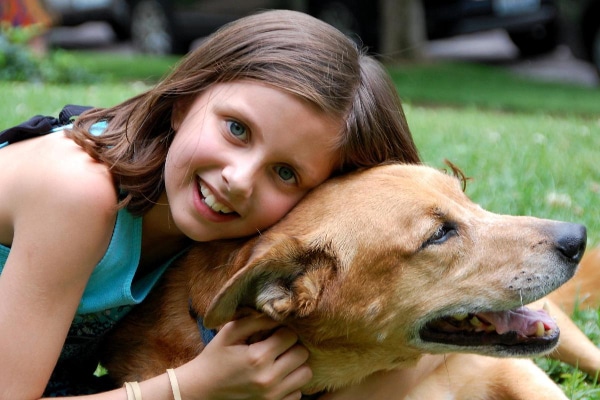
How much does a total hip replacement cost?
The exact cost will vary depending on multiple factors. These include your dog’s size, co-existing health issues, and the pre-operative testing and post-operative monitoring your dog requires. A staff member at the facility performing the THR should be able to give you an estimate for the procedure.
Based on the advanced training and specialized surgical tools required, it’s easy to see why a hip replacement is a significant financial investment. This level of expertise and equipment will definitely factor into the cost of a dog’s hip replacement.
Because there are so many variables, there’s a large range of cost associated with canine total hip replacement, but on average the surgery costs $3,500-$7,000 per hip.

Is a canine total hip replacement worth it?
As with any higher cost veterinary treatment, you may be wondering if THR is worth the money and extensive aftercare. Unfortunately, in most situations where a hip replacement is recommended, the alternative is a lifetime of debilitating pain.
According to a study in the Journal of Veterinary Surgery, 82% of dog parents rated their satisfaction with their dog’s total hip replacement experience as “very good.” Additionally, 90-95% of dogs who undergo a total hip replacement do very well and have years of pain-free mobility they wouldn’t have otherwise had.
How long will a canine total hip replacement last?
In a vast majority of cases, the total hip replacement is successful and lasts for the lifetime of the dog. In a small number of dogs, the implant will fail and need to be replaced. But as long as the surgery site does not develop a severe infection, or the dog does not catastrophically injure the leg after surgery, total hip replacement lasts a lifetime.
Total hip replacement: A great option for many dogs
The idea that your dog may need a total hip replacement surgery can be scary, and you may have many questions. But with the right preparation, an amazing veterinary care team, and a lot of TLC from you, your dog can have a wonderful outcome—returning to an active, pain-free lifestyle for many years!
It is also worth noting that while hip dysplasia typically affects both hips, approximately 80% of dogs only require one hip to be replaced in order to significantly improve their mobility and quality of life. The surgeon will work with you to determine which hip is the best one to replace.
So if you are wondering if a total hip replacement could be the right solution for your dog’s hip pain, why not talk to your veterinarian? It never hurts to get more information on something that might help your beloved dog have more good days with you!
Has your dog had a total hip replacement?
Please share your experiences below to help other dog parents who are facing a THR with their dog.


My almost 5 yo GSD had total hip replacement 5 weeks ago tomorrow. He is doing exceptionally well (in my opinion). He walks really well. He is not yet putting all his weight on the foot. We go back for the 6 week X-ray in a week. I’m hoping that’s this is normal. And looking forward to finding out how to go about rehabilitation since I live in a quad level house.
I’m excited for him to get back into agility, rally, scent training, personal protection etc (he is an active guy) but also concerned about when he will get the green light to start building up his muscles. I do massaging but not sure where or what else to do.
Hi Andrea,
I am glad your boy is doing well and so far, the recovery has been uneventful and smooth. Getting established with a veterinary rehabilitation professional would be a great idea for you and your pup. They can do an assessment and then let you know what it will take to reach the goals you have for your boy’s future. Hoping the recheck revealed favorable results and praying all is well. Best wishes and keep up the good work!
Hi there,
My pup had THR 9 weeks ago. She acts like she is fully recovered and is stronger than ever pulling us on her leashed walks that she gets 4 times a day. We do still administer a sedative to keep her calm. With that being said she has gotten away from us / we have let our guard down a little bit. She gotten the zoomies and took off a few times and gotten up and down from the couch. We are tightening up around here and are going to better monitor her actions until we get the all clear. Her leg looks normal and she’s functioning the same. She did kick the leg out a couple times in a weird motion, but again functioning normal when walking. Should I be concerned about this motion?
Hi Anna,
I am glad your girl’s surgery was a success and she is feeling so well! Without seeing the abnormal leg motion myself it is hard to say for sure if it is cause for concern. If your pup is still walking normally otherwise and is showing no signs of pain, I would not think there is an issue. Just to err on the side of caution, it may be a good idea to inform your vet about this new movement. Hoping things are still going well and praying your girl will make a full recovery. Best wishes to you both!
Our dog Liberty had THR 5 days ago and now she is home needs her meds administered. She likes her liquid meds and will take pills at a push but getting her to take her Tralieve pills is near impossible. You think she has swallowed it but she then spits it out. I have disguised the pills to no avail. I have arthritis in my hands which are getting quite painful trying to administer the pills. What more can I do? Susan
Hi Susan,
I am sorry Liberty is giving you some trouble with taking her medicine. Please make sure your vet is aware of this issue. They may be able to get this in a liquid form or switch to a different medication all together. Also, here is a link to an article that may offer some new ideas (great advice in the comments section as well): Your Dog Won’t Take Pills? 5 Easy Solutions for Uncooperative Pooches
Hoping you can find a way to make this easier for you and Liberty. Wishing you both the best for smoother days ahead and praying for a full recovery for your sweet girl.
hello! so happy I found your website! my pup had hip replacement surgery 1 week ago and she is still limping and sometimes when she stands still she keeps the operated leg up for a few seconds.
it is normal for them to still limp 1 week after surgery?
she uses her leg and steps on it but since yesterday I noticed it being extra painful and I truly can’t afford going to the vet for an x-ray as the surgery costs almost got me bankrupt. any advice is much appreciated
Hi Alexandra,
I understand why you are worried about this lameness your dog is exhibiting. With her recent surgery it is good you are watching her closely and monitoring for any signs of trouble. Unfortunately, without examining her myself, I can’t tell if this is cause for concern or not. The only way to find out if this is normal for this stage of healing or if there is an issue is to have your vet take a look at your pup. Please let your vet know you have financial concerns and limitations. They should be able to work with you to keep cost at a minimum but still offer some solutions. Hoping you can get the answers you need and ensure your girl is headed in the right direction. Wishing you both the best and praying for a positive outcome!
My dog had a THR last April, his recovery went amazingly, and all of his follow up scans showed no issues, but I have now noticed him limping on this leg occasionally after he’s been running around and not using it as well as he did before, could this be something serious? I’m reluctant to take him back to the surgeon straight away as the vet bills were astronomical and he is insured but it is now classed as a pre existing condition so it’s not covered until the two year mark, any suggestions would be muchly appreciated 🥺
Hi Beth,
I understand your concern for your boy and agree this new lameness is worrisome. I do think it would be wise to have him evaluated, but maybe start with your regular veterinarian instead of going straight to the orthopedic surgeon. At this point, we aren’t sure if the problem is his hip or if there is something else going on. I would let your vet localize the issue and if it is indeed hip related, then you can move forward with scheduling an appointment with the specialist. Hoping you can get some answers quickly and praying for good news.
We have the same issue. I am in the UK. I have follwed your advice and booked him in with his regular vet but thext appt is in 6 days time. Shall I pur him back on crate rest until he can be evaluated?
Hi Julie,
I am sorry your boy has experienced this setback. I do think crate rest would be a good idea until your vet can investigate. While it may not be needed, I would rather err on the side of caution and keep his activity to a minimum. Hoping for clear answers and wishing you both all the best.
My dog is a 155 lbs. can he have THP????
Hi Mark,
There are many factors that affect whether a dog is a candidate for THP surgery. If your dog is severely overweight, this could be a concern. The best way to find out if your dog would benefit from a procedure like this is to have your dog evaluated by your vet or an orthopedic specialist.